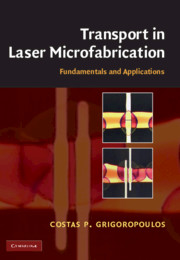Book contents
- Frontmatter
- Contents
- Preface
- 1 Fundamentals of laser energy absorption
- 2 Lasers and optics
- 3 Thermal processes in laser–materials interactions
- 4 Desorption at low laser energy densities
- 5 Dynamics of laser ablation
- 6 Ultrafast-laser interactions with materials
- 7 Laser processing of thin semiconductor films
- 8 Laser-induced surface modification
- 9 Laser processing of organic materials
- 10 Pulsed-laser interaction with liquids
- 11 Laser cleaning of particulate contaminants
- 12 Laser interactions with nanoparticles
- 13 Laser-assisted microprocessing
- 14 Nano-structuring using pulsed laser radiation
- Index
- References
5 - Dynamics of laser ablation
Published online by Cambridge University Press: 04 December 2009
- Frontmatter
- Contents
- Preface
- 1 Fundamentals of laser energy absorption
- 2 Lasers and optics
- 3 Thermal processes in laser–materials interactions
- 4 Desorption at low laser energy densities
- 5 Dynamics of laser ablation
- 6 Ultrafast-laser interactions with materials
- 7 Laser processing of thin semiconductor films
- 8 Laser-induced surface modification
- 9 Laser processing of organic materials
- 10 Pulsed-laser interaction with liquids
- 11 Laser cleaning of particulate contaminants
- 12 Laser interactions with nanoparticles
- 13 Laser-assisted microprocessing
- 14 Nano-structuring using pulsed laser radiation
- Index
- References
Summary
Introduction
Various theoretical models have been proposed to describe material removal from a solid surface heated by laser irradiation. The thermal models of Afanas'ev and Krokhin (1967), Anisimov (1968), and Olstad and Olander (1975) represent early theoretical contributions to this problem. Chan and Mazumder (1987) developed a one-dimensional steady-state model describing the damage caused by vaporization and liquid expulsion due to laser–material interaction. Much of the above work was driven by laser applications such as cutting and drilling, and was thus focused primarily on modification of the target's morphology, with no particular interest in the detailed description of the properties and dynamics of the evaporated and ablated species. Moreover, these models dealt with continuous-wave (CW) laser sources, or relatively long (millisecond) time scales.
During the first stage of interaction between the laser pulse and the solid material, part of the laser energy is reflected at the surface and part of the energy is absorbed within a short penetration depth in the material. The energy absorbed is subsequently transferred deeper into the interior of the target by heat conduction. At a later stage, if the amount of laser energy is large enough (depending upon the pulse length, intensity profile, wavelength, and thermal and radiative properties of the target material), melting occurs and vaporization follows. The vapor generated can be ionized, creating high-density plasma that further absorbs the incident laser light. Effects of this laser-plasma shielding have been shown via the simplified one-dimensional model of Lunney and Jordan (1998).
- Type
- Chapter
- Information
- Transport in Laser MicrofabricationFundamentals and Applications, pp. 109 - 145Publisher: Cambridge University PressPrint publication year: 2009



